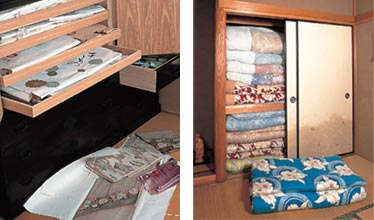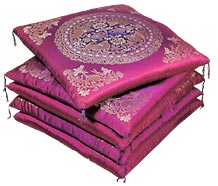 |
|
 |
|
Above left: Each folded kimono is placed in its own thick Japanese-paper wrapping,
and then placed in a specially made chest. Because of their straight tailored lines, kimono can be folded into a flat, rectangular shape, free of wrinkles and taking up little space.
Above center: Futon and other bedding are folded and placed in an oshiire closet. In a Japanese-style room, the closet is an important place for storage.
Above right: These cotton-stuffed zabuton cushions are placed on
the tatami mat floor — one for each person. Long ago, straw
was woven into a round cushion called enza. Today's zabuton
evolved from them.
|
Folding screens, with their beautiful paintings of different subjects, are often admired as artwork today, but years ago they were used to divide a room or keep drafts away. They created space within a room to suit the needs of the moment, and offered decoration as well, so they were a welcome addition to the home. When they were not needed, they could be folded up and put out of the way.
That is another example of how, over the centuries, the Japanese looked on household furniture as something to be used, then neatly folded or stacked away until needed again. This perspective led to the development of many things that can be made small for easy storage.
For example, take the excellent Japanese invention, the folding sensu fan. Unlike the flat uchiwa fan, the folding variety is highly portable and takes up almost no space when stored. Japan began exporting folding fans to China around the 12th century, and they spread from there to Europe.
The kimono is ideal for folding away when not in use. Because of its straight tailored lines, a folded kimono lies low and flat, wrinkle-free. Many will fit in a drawer. And then there is the furoshiki, a square cloth used to wrap and carry everything from a small cake box or a long saké bottle to a big futon. When this multi-purpose piece of cloth is not in use, it will be folded up small — something you cannot do with a bag.
Fold up small, open up big. This wonderful idea from Japan has high-tech applications, too. In 1997, a radio astronomy satellite called Haruka was launched on a rocket belonging to Japan's Institute of Space and Astronautical Science. The satellite's radio telescope was designed with a massive parabolic antenna measuring 10 meters in diameter. The question scientists had to ask themselves was: "How can we get such a big object into space?" After intensive research, they succeeded in developing the technology to fold the antenna up small, launch it into space, and unfurl it there.
Fold it, stack it, put it away... and apply technology to make it easy to do so. Japan's expertise in storage has evolved to meet lifestyle needs and customs, and you can see it today in both everyday and high-tech items.  |